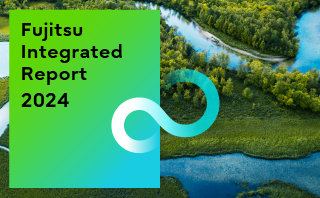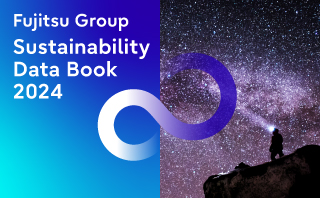-
Sustainability at Fujitsu Group
- Sustainability Management in the Fujitsu Group
- GRB(Global Responsible Business)Goals for FY2025
- GRB(Global Responsible Business)Goals and Achievments for FY2022
- Fujitsu's accessibility
- Stakeholder Engagement
- United Nations Global Compact
- SDG-related Activities in Fujitsu
- External Recognition and Awards
-
Global Responsible Business
- Environment
-
- Environmental Management
- The Fujitsu Group Environmental Vision on Climate Change
- Living in Harmony with Nature (Conservation of Biodiversity)
- Environmental Action Plan
- Environmental Data
- Environmental Communication
- Environmental Social Activities
- Disposal and Recycling of ICT products
- Environmental Considerations in ICT Products
- Governance
-
Data and Documents
- Fujitsu Group Sustainability Data Book 2024
- Social, Governance and Environmental data
- Independent Assurance Report

- GRI Standards / United Nations Global Compact (UNGC) principles Comparison Table
- SASB Standards Comparison Table
- Sustainability Information Disclosure Framework
- Link to regions responsible business reports
- Contact
- Sitemap
SDG-related Activities in Fujitsu
SDG-related Activities in Fujitsu
The Sustainable Development Goals (SDGs) adopted by the United Nations in 2015 are a set of common goals to be achieved worldwide by 2030. Fujitsu’s purpose is “to make the world more sustainable by building trust in society through innovation” and our company has made a commitment, both internally and externally, to contribute to achieving the SDGs. As a global enterprise that for decades has leveraged technology to create value for society, Fujitsu has a responsibility to proactively contribute to societal transformation. To help make the world more sustainable, we aim to generate larger and more beneficial impacts for society, which will also help to spur ongoing sustainable corporate growth. In the Medium-Term Management Plan released in May 2023, we set out our vision for 2030 of being “a technology company that realizes net positive (*1) through digital services". To achieve this vision, our aim is to contribute to the SDGs by working on the Essential Contributions to Materiality: Solving global environmental issues, developing a digital society, and improving people’s well-being.
Fujitsu believes the SDGs essentially define a system transformation that must be achieved by 2030 so that the predicted global population of more than 9 billion by 2050 will be able to live well, within the limitations of our planet. The issues highlighted in the SDGs involve a complex web of environmental, social, and economic elements. One key to solving these inherent problems is through society-wide digital transformation (DX). Fujitsu will harness the power of digital technology to create ecosystems that transcend industry boundaries and assist in the transformation of our customers and our own organizations, while playing a part in delivering fundamental changes to the way society interacts and contributes to the resolution of societal challenges.
The SDGs are an overarching framework of global social and environmental needs and form a common language for all stakeholders. Fujitsu will use its efforts to realize the SDGs as an opportunity for co-creation with a wide range of stakeholders, including international agencies, national and regional governments, private companies, non-governmental organizations (NGOs), and non-profit organizations (NPOs). By embracing a multifaceted approach to societal challenges, we can create and maximize positive impacts on an even larger scale.
- *1Fujitsu defines net positive as follows: “In addition to maximizing financial returns, we are committed to solving global environmental problems, developing a digital society, and improving people’s well-being. Technology and innovation will have a positive impact on society as a whole.”
Practical Application Within Fujitsu
We have built a framework that prompts all our employees to consider which of the 169 targets defined in the SDGs are relevant to our services and solutions when they are engaged in product planning and business discussions and when they issue press releases.
The objective is to make our employees routinely conscious of whether they are contributing to achieving the SDGs so that they approach their business activities from the standpoint of addressing social issues.

Using Digital Technology and Services to Contribute to the SDGs
Supercomputer Fugaku technology supporting detailed prediction of meteorological disasters and helping build resilient societies
With the growing number of meteorological disasters in recent years, highly accurate predictions have become increasingly important in minimizing the damage caused. The Japan Meteorological Agency (JMA) collects and analyzes both domestic and international observations of events such as torrential rain, earthquakes and tsunamis, which it uses to generate disaster prevention and meteorological data on a daily basis. Providing this data to disaster prevention agencies and to citizens contributes to disaster preparedness and helps maintain traffic safety. However, the August 2018 and March 2023 meetings of the Council for Transport Policy’s Environment subcommittee highlighted the need to further enhance the accuracy of forecasting and promote the sharing and use of data with private-sector enterprises and research facilities.
Fujitsu has some 20 years’ of experience operating community systems such as the JMA’s ADESS (*2) and AMeDAS Center systems (*3). Fujitsu’s PRIMEHPC FX1000 (*4) uses the same technology as the Supercomputer Fugaku (*5). This supercomputer system introduced in 2023 enables to improve the accuracy of linear rainband prediction. We followed this by building a new 11th-generation supercomputer system that incorporates the PRIMERGY CX400 M7 (*6) servers, and the new began operating in March 2024. Integrating an 11th-generation supercomputer system and a Linear precipitation zone prediction Supercomputer provided apporximately four times the computing capacity of the previous system. This made it possible to both improve prediction accuracy for linear rainbands and conduct research aimed at gaining a clearer understanding of linear rainbands. It also enabled the sharing of large volumes of meteorological data.
In its Numerical Weather Prediction (NWP) Strategic Plan Toward 2030 (*7), the JMA promotes the development of numerical weather prediction technology for four target areas: prevention of disasters caused by heavy rain, prevention of disasters caused by typhoons, contributions to socioeconomic activity, and adaptation to global warming. Fujitsu is a Sustainability Transformation (SX) partner supporting the work of the JMA, where stable operation 24 hours a day, 365 days a year, is essential. As such, we work with the Agency with the aims of providing highly accurate prediction of meteorological disasters and building resilient communities.
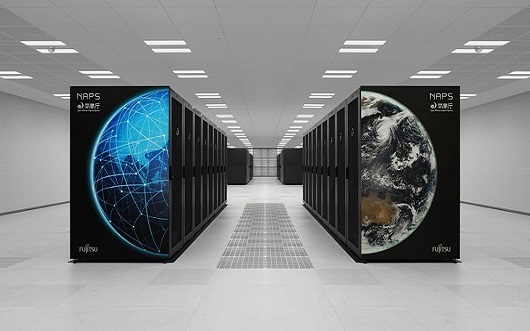 11th-generation supercomputer system (*8)
11th-generation supercomputer system (*8)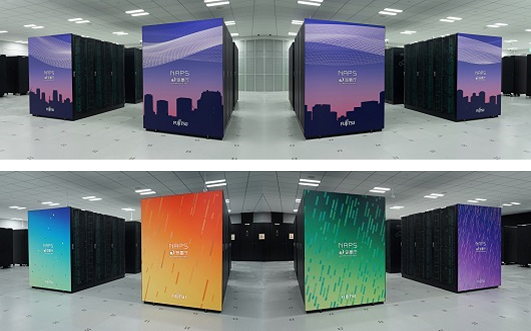 Linear precipitation zone prediction Supercomputer
Linear precipitation zone prediction Supercomputer- *2ADESS: The Japan Meteorological Agency’s weather data transmission processing system
- *3AMeDAS Center System: The Japan Meteorological Agency’s integrated processing system for AMeDAS data collected from regional weather observation systems.
- *4FUJITSU Supercomputer PRIMEHPC FX1000: Equipped with an A64FX CPU that uses Scalable Vector Extension (SVE), which extends the Armv8-A instruction set architecture for supercomputers. Offers both high performance levels per unit of power along with extremely high computing efficiency using the enormous memory bandwidth provided by the high-performance HBM2 3D stacked memory.
- *5Supercomputer Fugaku: Jointly developed by RIKEN and Fujitsu.
- *6PRIMERGY CX400 M7: Equipped with 4th generation Intel® Xeon® scalable processors. Multi-node server capable of accommodating up to four 2U-size server nodes.
- *7The Japan Meteorological Agency website "Numerical Weather Prediction (NWP) Strategic Plan Toward 2030
 "
" - *8Cabinet-design NAPS: The NAPS name on the panel of the main unit is not a Fujitsu trademark and was coined by the Japan Meteorological Agency for their Numerical Analysis and Prediction System, which includes this system.
- Fujitsu delivers new supercomputer system to Japan Meteorological Agency to improve prediction accuracy for typhoons and torrential rain
- Fujitsu provides supercomputer system to the Japan Meteorological Agency for forecasting of linear rainbands and torrential rains
Key SDGs related to this project
Optical Network Business Initiatives Working Towards a Decarbonized Society
With the nationwide roll-out of 5G services in Japan, users are increasingly turning towards services that support high data capacities for large data files such as video. This is expected to further increase power consumption, which highlights the need for initiatives to help decarbonize communications providers and datacenter businesses.
To address this issue, Fujitsu has been focusing its energies on developing the industry leading optical transmission technology to enable large capacity and low power consumption. This technology has now been adopted by major network service providers in Japan. NTT Group is building a next-generation network with Fujitsu’s optical transmission system that leverages liquid cooling technology. KDDI and SoftBank have also newly deployed Fujitsu solutions to boost the capacity of their network infrastructure, while significantly reducing their power consumption and decarbonizing their entire optical network.
- 1FINITY
Fujitsu 1FINITY-series Open Line System which can be connected to third-party products through an open interface realizes configuring network that integrates the IP layer and optical transmission layer (*9). This allows optical connections with routers and between optical core networks. 1FINITY series can also provide flexibility to accommodate data traffic increase, as it deploys disaggregation architecture for easy capacity expansion. In addition, the 1FINITY Ultra Optical System uses liquid cooling technology -- a world’s first in optical transmission equipment -- enabling world-leading data capacity and reduced power consumption, thereby contributing to the goal of carbon neutrality.
Fujitsu will continue to leverage its advanced technology to address the issues facing communities and people, helping to build a society that will meet the Sustainable Development Goals (SDGs).
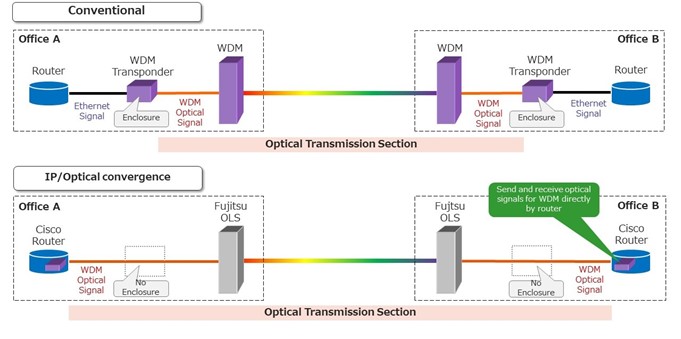 Difference between conventional configuration and IP /Optical layer convergence (KDDI case)
Difference between conventional configuration and IP /Optical layer convergence (KDDI case)
- *9Refers to configurations that use OLS and WDM for transmission where optical signals for WDM are sent directly from the router.
- Fujitsu 1FINITY™ Ultra Optical System selected by NTT for next Japan-wide core network
- KDDI, Cisco, and Fujitsu start full-scale operation of telecommunications network to reduce power consumption by approximately 40%
- SoftBank Corp. completes nationwide expansion of all optical network in core areas in Japan leveraging Fujitsu’s disaggregation-type optical transmission system
Key SDGs related to this project
AI technology to detect pancreatic cancer from non-contrast CT scans -- Contributing to a healthier society --
Pancreatic cancer is a disease that is difficult to detect in the early stages, and it has proven difficult to establish a technology capable of identifying cancers beyond all doubt and thereby increasing the opportunities for detection in the initial stages.
To address this problem, Fujitsu has been collaborating since April 2022 with the Southern TOHOKU General Hospital (*10) and others to promote the development of AI technology to detect pancreatic cancer from non-contrast CT scans, such as those widely carried out during general health checks and similar procedures.
Due to the low levels of contrast in non-contrast CT scans, it has always been difficult to identify the location of the pancreas and detect cancers. So, Fujitsu has used AI to develop a technology that estimates the continuity across adjacent cross-sectional scans, taking into account the patient’s anatomy. It automatically conducts three-dimensional analysis in areas with strong continuity in the images and planar analysis in areas with weak continuity. The results of evaluations of the CT scans from the Southern TOHOKU General Hospital show that locations where cancer is suspected in the pancreas area were successfully detected with 90% accuracy.
This AI technology is the result of the use of converging technologies (*11) that integrate Fujitsu’s image analysis technology with the clinical observations made by the Southern TOHOKU General Hospital, and is likely to make a significant contribution to improving the early discovery of pancreatic cancer. In 2023, this technology was unveiled to over 20,000 physicians and other participants at JDDW 2023 (*12), where it demonstrated the advanced level of the technology addressing social needs.
Fujitsu will continue to make its research findings available to treatment and health-promotion services as part of our contribution towards building healthy communities.
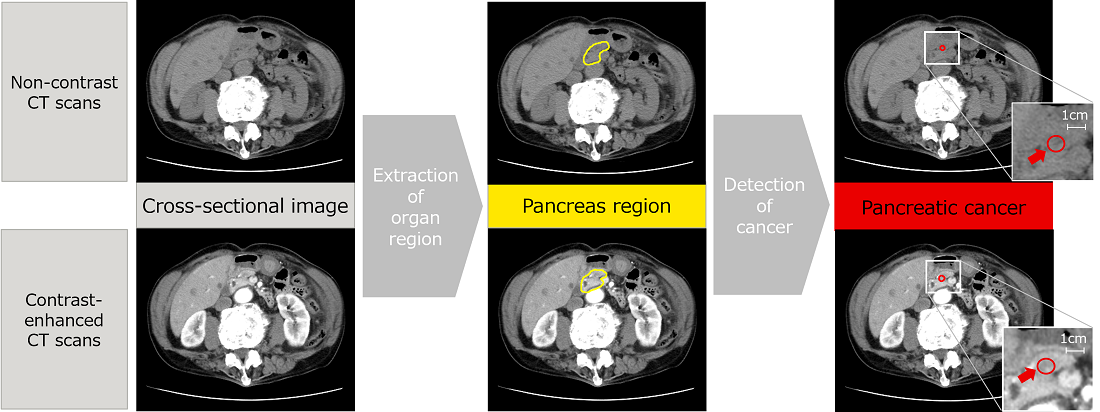 Detection of suspected pancreatic cancer using the newly developed technology
Detection of suspected pancreatic cancer using the newly developed technology
- *10Southern TOHOKU General Hospital: Located in Koriyama City, Fukushima Prefecture, Japan; Founder and Chairman: Dr. Kazuo Watanabe
- *11Converging technologies: A focus area for Fujitsu R&D, this is a field where science and technology from two or more different sectors are combined in a single technology to achieve a specific goal
- *12
Key SDGs related to this project
Launch of a smartphone-based integrated information sharing system to support on-site fire-fighting and first-aid activities
When Fire-Fighters and Emergency Medical Technicians are on the scene of an accident, they can check the details of notifications and instructions in on-board devices known as Automatic Vehicle Monitoring (AVM) systems installed in the vehicles. However, these systems are fixed in place and not portable, and are also expensive to install, both of which are issues making their installation in all vehicles difficult. Also, to enhance fire-fighting forces and cope with the increasing number of emergency call-outs, there is demand for reduced workloads and effective information sharing through the use of smart devices in order to reduce employee fatigue and eliminate workforce shortages.
To address these issues, Fujitsu has used its expertise in building Fire-Fighting command systems to develop a smartphone-based integrated information sharing system that Fire-Fighters and Emergency Medical Technicians can use on-site at accidents and other disasters.
This system provides a wide range of functions to support fire-fighters and paramedics right from the initial call-out through to writing up their reports. This includes a push notification function that uses vibrations to prevent miscommunication in radio calls and missed notifications involving vital information, a timeline function that uses a chat function to share real-time status updates from the different services even after responders have exited their vehicles, and a function that records data such as casualties’ vital signs and treatment details to assist responders in generating incident reports after they leave the scene.
The system also includes a function for reserving the water source (*13) that allows the availability of fire hydrants to be shared with other fire engines, a name search function to assist in selecting a destination medical institution, and search filtering functions that enables paramedics to select for specific hospital departments, such as internal medicine or pediatrics. In the event of a emergency such as a large-scale disaster situation, this system allows flexible vehicle operation. For example, it can be used as an AVM system in transport vehicles not normally equipped with AVM, such as loudspeaker vans and shipping vehicles.
Going forward, Fujitsu will continue to support the on-site activities of fire and ambulance services, contributing to the establishment of resilient communities where citizens can enjoy rich and secure lives.
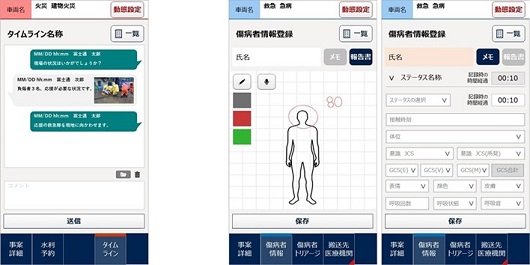 Screenshots of the timeline and casualty data recording functions
Screenshots of the timeline and casualty data recording functions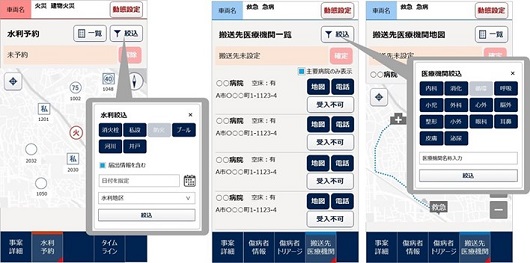 Screenshots of the water supply reservation function and filtered search function for destination medical institutions
Screenshots of the water supply reservation function and filtered search function for destination medical institutions- *13Because each fire hydrant can only be used by one vehicle during fire-fighting activities, this function reserves fire hydrants so that firefighting vehicles can share information on which vehicle is using which fire hydrant in advance.
Key SDGs related to this projec
Technology to solve both high electricity consumption and global GPU shortage as global demand for AI increases
Demand for AI is currently increasing at a dramatic rate worldwide. However, due to the enormous amounts of computing power and electricity required to make advanced AI a reality, there are serious concerns about the environmental impacts of developing and running AI. Another important and emerging issue is the global supply shortage of the GPU chips that are essential for AI processing.
To help resolve these issues, Fujitsu is developing and supplying the ‘AI Computing Broker’ middleware technology (*14), which allows AI calculations to be executed efficiently even with a small number of GPU chips. This is the world’s first technology capable of identifying and prioritizing, in real-time which of multiple processes being run concurrently will achieve the greatest improvements in processing efficiency if allocated a GPU.
This technology allows AI processing to be performed with half, or even less, of the usual number of GPUs. The latest GPUs consume 700 watts of power per chip, making them the major consumers of power in AI computing. Reducing the number of GPUs used significantly reduces the power consumption in AI development and operation. For example, for the very large 10,000-GPU systems needed for large-scale AI development, annual power consumption can be reduced by as much as 30,660 MWh (*15).
Our goal at Fujitsu is to provide computing platforms that help to generate the innovations that will build a future sustainable society.
 Performance evaluation demo (3D protein structure prediction)
Performance evaluation demo (3D protein structure prediction)
Protein structure prediction using 2 GPUs (left image) compared with 1 GPU with AI Computing Broker (right image) yielded approximately the same number of predicted protein structures in 1 minute. The GPU usage shown on the left of both screens indicates that a high level of usage was maintained when AI Computing Broker was used. (The horizontal axis in the graphs shows time elapsed.)
- *14AI Computing Broker development and supply: Currently provided to pilot users
- *15Annual power consumption reduction of 30,660 MWh: This is equivalent to the annual power consumption of around 5,400 4-person households in Japan. <Annual power consumption by a 4-person household of around 5,700kWh): Calculated using the Japanese Ministry of the Environment’s Survey on the Actual Conditions of Carbon Dioxide Emissions from Residential Sector in FY2022>
Key SDGs related to this project

